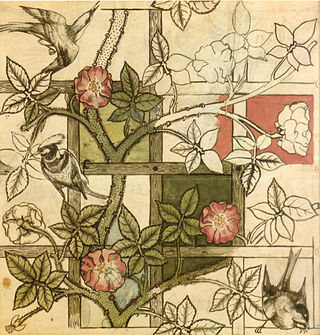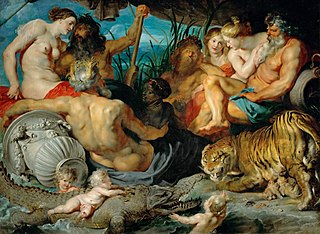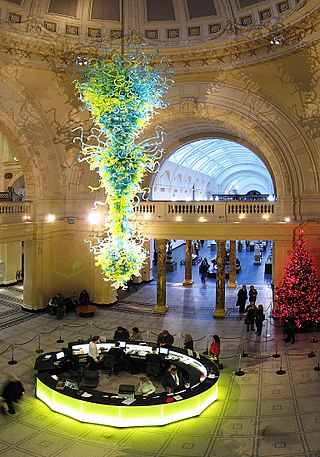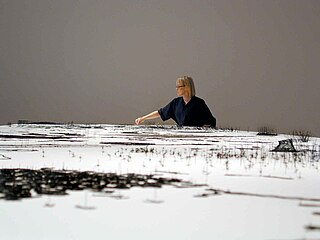
"Do it yourself" ("DIY") is the method of building, modifying, or repairing things by oneself without the direct aid of professionals or certified experts. Academic research has described DIY as behaviors where "individuals use raw and semi-raw materials and parts to produce, transform, or reconstruct material possessions, including those drawn from the natural environment ". DIY behavior can be triggered by various motivations previously categorized as marketplace motivations, and identity enhancement.

The Arts and Crafts movement was an international trend in the decorative and fine arts that developed earliest and most fully in the British Isles and subsequently spread across the British Empire and to the rest of Europe and America.

The decorative arts are arts or crafts whose aim is the design and manufacture of objects that are both beautiful and functional. This includes most of the objects for the interiors of buildings, as well as interior design, but typically excludes architecture. Ceramic art, metalwork, furniture, jewellery, fashion, various forms of the textile arts and glassware are major groupings.

Fiber art refers to fine art whose material consists of natural or synthetic fiber and other components, such as fabric or yarn. It focuses on the materials and on the manual labor on the part of the artist as part of the works' significance, and prioritizes aesthetic value over utility.

A work of art, artwork, art piece, piece of art or art object is an artistic creation of aesthetic value. Except for "work of art", which may be used of any work regarded as art in its widest sense, including works from literature and music, these terms apply principally to tangible, physical forms of visual art:

Studio pottery is pottery made by professional and amateur artists or artisans working alone or in small groups, making unique items or short runs. Typically, all stages of manufacture are carried out by the artists themselves. Studio pottery includes functional wares such as tableware and cookware, and non-functional wares such as sculpture, with vases and bowls covering the middle ground, often being used only for display. Studio potters can be referred to as ceramic artists, ceramists, ceramicists or as an artist who uses clay as a medium.

American craft is craft work produced by independent studio artists working with traditional craft materials and processes. Examples include wood, glass, clay (ceramics), textiles, and metal (metalworking). Studio craft works tend to either serve or allude to a functional or utilitarian purpose, although they are just as often handled and exhibited in ways similar to visual art objects.

American Craftsman is an American domestic architectural style, inspired by the Arts and Crafts movement, which included interior design, landscape design, applied arts, and decorative arts, beginning in the last years of the 19th century. Its immediate ancestors in American architecture are the Shingle style, which began the move away from Victorian ornamentation toward simpler forms, and the Prairie style of Frank Lloyd Wright.

The Museum of Arts and Design (MAD), based in Manhattan, New York City, collects, displays, and interprets objects that document contemporary and historic innovation in craft, art, and design. In its exhibitions and educational programs, the museum celebrates the creative process through which materials are crafted into works that enhance contemporary life.

Art jewelry is one of the names given to jewelry created by studio craftspeople. As the name suggests, art jewelry emphasizes creative expression and design, and is characterized by the use of a variety of materials, often commonplace or of low economic value. In this sense, it forms a counterbalance to the use of "precious materials" in conventional or fine jewelry, where the value of the object is tied to the value of the materials from which it is made. Art jewelry is related to studio craft in other media such as glass, wood, plastics and clay; it shares beliefs and values, education and training, circumstances of production, and networks of distribution and publicity with the wider field of studio craft. Art jewelry also has links to fine art and design.
Judith Schaechter is a Philadelphia-based artist known for her work in the medium of stained glass. Her pieces often use symbolism from stained glass and Gothic traditions, but the distorted faces and figures in her work recall a 20th century German Expressionist painting style and her subject matter is secular. Shaechter's work often involves images that might be considered disturbing such as death, disease, or violence. Early Schaechter pieces, for example, such as King of Maggots and Vide Futentes make use of memento mori, symbols of death found in church architecture during medieval times.
Studio furniture is an American sub-field of studio craft centered on one-of-a-kind or limited production furniture objects designed and built by craftspeople. The work is made in a craftsperson's studio setting as opposed to being made in a high volume factory. This conception of the site of production as being a studio links studio furniture to studio art and reflects its status as an individual creative process. From the earliest furniture of the Arts and Crafts movement to modern-day works of art, studio furniture can be generalized as handmade functional objects that serve as a medium for intellectual and emotional expression and indicate social and cultural concerns of the maker or community. The Furniture Society is an organization devoted to the history and legacy of studio furniture.

Anne Wilson is a Chicago-based visual artist. Wilson creates sculpture, drawings, Internet projects, photography, performance, and DVD stop motion animations employing table linens, bed sheets, human hair, lace, thread and wire. Her work extends the traditional processes of fiber art to other media. Wilson is a professor in the Department of Fiber and Material Studies at The School of the Art Institute of Chicago.
Paul J. Smith was an arts administrator, curator, and artist based in New York. Smith was professionally involved with the art, craft, and design fields since the early 1950s and was closely associated with the twentieth-century studio craft movement in the United States. He joined the staff of the American Craftsmen's Council in 1957, and in 1963 was appointed Director of the Museum of Contemporary Crafts, a position he held for the next 25 years. In September 1987, he assumed the title of director emeritus and continued to work as an independent curator and consultant for museums, arts organizations, and collectors.

Lisa Gralnick is an American contemporary metalsmith, studio jeweler and academic. She works in the field of craft and art jewelry. Gralnick says: "I have chosen to make jewelry, which is traditionally considered 'craft', and I do enjoy the processes and techniques that allow me to execute my work without technical faults. But 'craft' is only a means to an end for me, as it is for many artists. My desire to push the limits of jewelry and expand on them, to comment on its traditions and associations, is more the concern of any artist."
Myra Mimlitsch-Gray is an American metalsmith, artist, critic, and educator living and working in Stone Ridge, New York. Mimlitsch-Gray's work has been shown nationally at such venues as the John Michael Kohler Arts Center, Museum of the City of New York, Metropolitan Museum of Art, Cooper-Hewitt Smithsonian Design Museum, and Museum of Arts and Design. Her work has shown internationally at such venues as the Middlesbrough Institute of Modern Art, Stadtisches Museum Gottingen, and the Victoria and Albert Museum, and is held in public and private collections in the U.S, Europe, and Asia.
Judy Kensley McKie is an American artist, furniture designer, and furniture maker. She has been making her signature style of furniture with carved and embellished animal and plant motifs since 1977. She is based in Boston, Massachusetts.
Glenn Adamson is an American curator, author, and historian whose research and work focuses on the intersections of design, craft, and contemporary art. Adamson is currently editor-at-large of The Magazine Antiques, editor of Journal of Modern Craft, a freelance writer and a curator. Adamson has held previous notable appointments as the Director of the Museum of Arts and Design, Head of Research at the Victoria and Albert Museum, and as Curator at the Chipstone Foundation.
Objects: USA (1969) was a groundbreaking exhibition considered a watershed in the history of the American studio craft movement. It "blurred lines between art and craft, artist and artisan". The exhibition featured a survey collection of craft works by artists from across the United States. Artists were approached and works chosen by New York gallery owner Lee Nordness and curator Paul J. Smith, the director of the Museum of Contemporary Crafts. The exhibition was funded by S. C. Johnson & Son, which purchased the pieces for the exhibition and later donated many of them to American museums. The Objects: USA exhibition appeared at thirty-three locations in the United States and Europe. The accompanying exhibition catalog Objects: USA (1970) became a classic reference work.

Ka Kwong Hui, also known as Hui Ka-Kwong (1922–2003) is a Chinese-born American potter, ceramist and educator. He is known for his fine art pottery work, a fusion of Chinese and American styles, and his work within the pop art movement.













